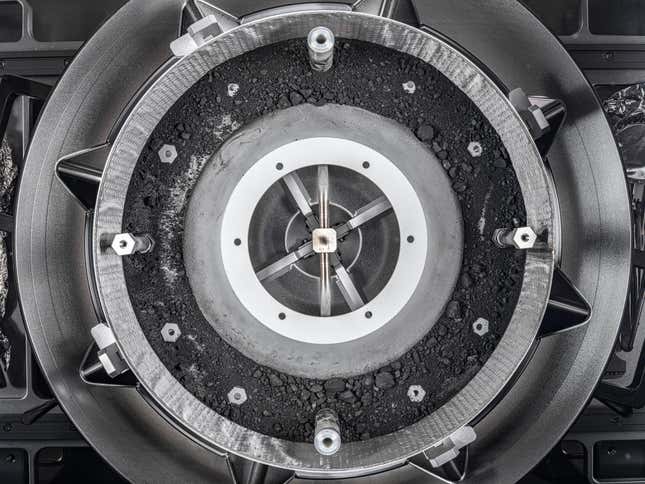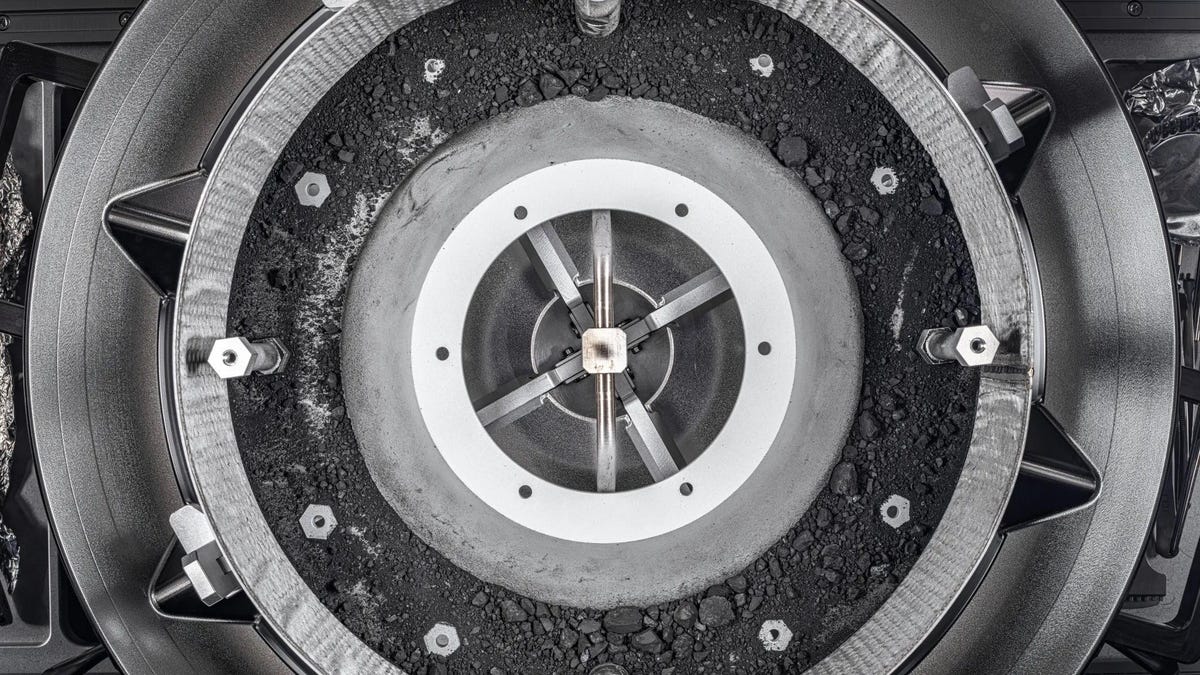The aluminum canister containing bits of an ancient space rock has finally been opened, revealing the bulk of the asteroid Bennu sample in all its glory.
Earlier this month, NASA’s OSIRIS-REx team managed to crack open the TAGSAM (Touch-and-Go Sample Acquisition Mechanism) head after developing new tools to deal with two stuck fasteners that stood in the way of the asteroid sample. With the sampler head finally open, NASA revealed the remainder of the unseen samples—and whoa is there ever a whole lot of asteroid inside. That’s great news for science teams around the world who are waiting to receive a piece that may contain clues about the origin of the solar system.
The photograph below was captured by the creative lead for the Advanced Imaging and Visualization of Astromaterials (AIVA), Erika Blumenfeld, and the project lead, Joe Aebersold, using manual high-resolution precision photography and a semi-automated focus stacking procedure, according to NASA.

A few steps remain before the bulk of the asteroid sample can be removed. The curation team will now remove the round metal collar and transfer the remaining sample from the TAGSAM head into smaller sample trays in the shape of a pie wedge. These trays will be photographed before the sample is weighed, packaged, and stored at NASA’s Johnson Space Center in Houston, Texas.
The sample’s weight is still to be determined, which will reveal the exact amount of the asteroid material that the OSIRIS-REx spacecraft delivered to Earth. When the aluminum lid to the sample canister was first removed, team members found black dust and debris on the avionics deck of the canister. They also removed some of the material from inside the canister with tweezers or a scoop while holding down the TAGSAM head’s mylar flap. The total amount of the sample weighed thus far is an estimated 8.8 ounces (250 grams) of rock and dust. With the bonus sample alone, NASA already surpassed its goal of bringing at least 2.12 ounces (60 grams) to Earth.
The OSIRIS-REx mission launched in September 2016 and reached asteroid Bennu in December 2018. The spacecraft snagged pieces of a small, near-Earth asteroid in October 2020 and began making its way back to Earth in May 2021.
The spacecraft dropped off the sample in the Utah desert in September 2023, but NASA has been struggling to crack open a round sampler head at the end of an articulated arm that the spacecraft used to grab the sample. In November, the curation team began work on developing new tools that could fit inside the glovebox that contains the canister and it finally succeeded at defeating those pesky fasteners.
The returned asteroid pieces will be divided among a sample analysis team of 230 global scientists for a deep dive into Bennu’s composition. NASA will keep at least 70 percent of the sample at Johnson Space Center for future research to take place decades from now, hoping to take advantage of advanced technology in the coming years. Some of the asteroid bits will also be made available for public display at the Smithsonian Institution, Space Center Houston, and the University of Arizona.
Bennu is a small, near-Earth asteroid that makes a close pass to Earth every six years or so. Scientists believe Bennu might have broken off from a much larger carbon-rich asteroid about 700 million to 2 billion years ago and drifted much closer to Earth since then. Analyzing bits of the asteroid in a lab will help scientists piece together clues on the origins of the solar system.
The final mass of the sample will be determined in the coming weeks, NASA stated. We can’t wait to find out more about the asteroid sample that keeps on giving.
For more spaceflight in your life, follow us on X (formerly Twitter) and bookmark Gizmodo’s dedicated Spaceflight page.

